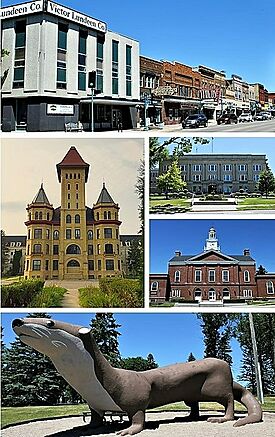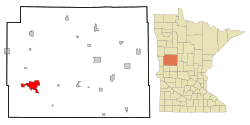Fergus Falls, Minnesota facts for kids
Quick facts for kids
Fergus Falls, Minnesota
|
||
|---|---|---|

Clockwise from top: Downtown Fergus Falls, Otter Tail County Courthouse, Fergus Falls City Hall, Otto the Otter in Grotto Park, Fergus Falls Regional Treatment Center (former state hospital)
|
||
|
||

Location of Fergus Falls in Otter Tail County, Minnesota (left) and of Otter Tail County in Minnesota (right)
|
||
| Country | United States | |
| State | Minnesota | |
| County | Otter Tail | |
| Platted | August 1870 | |
| Incorporated (village) | February 29, 1872 | |
| Incorporated (city) | March 3, 1881 | |
| Area | ||
| • City | 15.720 sq mi (40.715 km2) | |
| • Land | 14.388 sq mi (37.264 km2) | |
| • Water | 1.332 sq mi (34.496 km2) 8.20% | |
| Elevation | 1,194 ft (364 m) | |
| Population
(2020)
|
||
| • City | 14,119 | |
| • Estimate
(2022)
|
14,187 | |
| • Density | 986.0/sq mi (380.7/km2) | |
| • Urban | 13,116 | |
| • Metro | 60,626 (US: 156th) | |
| Time zone | UTC−6 (Central (CST)) | |
| • Summer (DST) | UTC−5 (CDT) | |
| ZIP Code |
56537
|
|
| Area code(s) | 218 | |
| FIPS code | 27-20906 | |
| GNIS feature ID | 2394758 | |
| Sales tax | 7.875% | |
Fergus Falls is a city in Minnesota, United States. It is the main city and county seat of Otter Tail County. This means it's the center for the county's government and business. In 2020, about 14,119 people lived here.
Contents
History of Fergus Falls
The city gets part of its name from the "falls" on the river. These falls were found in 1856 by Joe Whitford. He named them after his boss, James Fergus.
Later, in 1867, a man named George B. Wright bought the land. He built the Central Dam in downtown Fergus Falls around 1871. His son, Vernon Wright, later helped start the Otter Tail Power Company in 1907.
Fergus Falls became an official city in the late 1870s. It is located where forests meet wide-open plains. The area has many hills, lakes, and small rivers, shaped by ancient glaciers.
Early Challenges and Growth
In the early 1900s, two big tornadoes hit Fergus Falls. The second one, in 1919, was very strong. Only one church was left standing after this storm.
The dams built on the Otter Tail River starting in the 1880s were very important for the city's growth. They provided power and helped the economy.
After the American Civil War, many soldiers settled in this area. Most became farmers, growing crops like wheat and corn or raising dairy cows and hogs. The city's main streets, Lincoln Avenue and Union Avenue, were named to remember the Civil War. Older parts of town have streets named after Civil War generals like Sherman and Sheridan.
People and Cultures
When the city was first built, people from England and Scotland were in charge of businesses. Later, many Norwegian immigrants arrived, often by train. They were mostly dairy farmers and started many Lutheran churches in the area.
Over time, people from different backgrounds married each other. This helped to blend the different groups and reduce earlier divisions.
How the City Changed Over Time
In the late 1950s, Interstate 94 was built near Fergus Falls. This made it easier for people to travel. Many high school graduates started leaving to go to colleges in bigger cities.
As large farms replaced smaller family farms, Fergus Falls began to be seen as a place for retirement. But with the rise of the internet, more people could work from home. This brought new, younger families to the city. They were attracted by the beautiful nature, outdoor activities, and lower cost of living compared to larger cities.
Geography of Fergus Falls
Fergus Falls covers about 15.37 square miles (39.8 square kilometers). Most of this area is land, and a smaller part is water, including lakes and rivers.
Main Roads and Highways
Several important roads run through Fergus Falls. These include:
 Interstate 94
Interstate 94 U.S. Highway 59
U.S. Highway 59 Minnesota State Highway 210
Minnesota State Highway 210- Otter Tail County Highway 1
- Otter Tail County Highway 82
- Otter Tail County Highway 88
Population Information
| Historical population | |||
|---|---|---|---|
| Census | Pop. | %± | |
| 1880 | 1,635 | — | |
| 1890 | 3,772 | 130.7% | |
| 1900 | 6,072 | 61.0% | |
| 1910 | 6,887 | 13.4% | |
| 1920 | 7,581 | 10.1% | |
| 1930 | 9,389 | 23.8% | |
| 1940 | 10,848 | 15.5% | |
| 1950 | 12,917 | 19.1% | |
| 1960 | 13,733 | 6.3% | |
| 1970 | 12,443 | −9.4% | |
| 1980 | 12,519 | 0.6% | |
| 1990 | 12,362 | −1.3% | |
| 2000 | 13,471 | 9.0% | |
| 2010 | 13,138 | −2.5% | |
| 2020 | 14,119 | 7.5% | |
| 2022 (est.) | 14,187 | 8.0% | |
| U.S. Decennial Census 2020 Census |
|||
Population in 2020
In 2020, Fergus Falls had 14,119 people living in 6,171 households. The city's population density was about 981.6 people per square mile.
Most of the people living in Fergus Falls are White (90.2%). Other groups include African American (1.7%), Native American (0.8%), and Asian (0.8%). About 2.5% of the population identified as Hispanic or Latino.
About 20% of the residents were under 18 years old. About 24.4% were 65 years or older.
Population in 2010
In 2010, the city had 13,138 people. The population density was about 931.1 people per square mile.
Most residents (95.5%) were White. Other groups included African American (1.1%), Native American (0.8%), and Asian (0.7%). About 1.6% of the population was Hispanic or Latino.
The average age in the city was 43.4 years. About 21.4% of residents were under 18. About 22.2% were 65 or older.
Economy and Jobs
Fergus Falls has a varied economy. This means it has many different types of jobs and businesses. Important industries include healthcare, manufacturing (making goods), and public utilities (like power companies).
The biggest employer in the city is Lake Region Healthcare. This is a large health system with a hospital, a cancer research center, and clinics.
Major Employers in Fergus Falls
Here are some of the largest employers in the city, based on a 2022 report:
| # | Employer | Type of Business | # of Employees | Percentage |
|---|---|---|---|---|
| 1 | Lake Region Healthcare Corporation | Hospital | 835 | 8.88% |
| 2 | Fergus Falls Public Schools ISD #544 | Education | 418 | 4.44% |
| 3 | Otter Tail County | Government | 396 | 4.21% |
| 4 | Otter Tail Power Company | Public Utility | 340 | 3.61% |
| 5 | Pioneer Home | Nursing Home | 215 | 1.95% |
| 6 | Veterans Home | Nursing Home | 194 | 2.29% |
| 7 | City of Fergus Falls | Municipality | 192 | 2.06% |
| 8 | LB Homes | Nursing Home | 183 | 2.04% |
| 9 | Northern Contours | Manufacturing | 161 | 1.71% |
| 10 | Productive Alternatives | Vocational Rehabilitation Service | 157 | 1.67% |
| — | Total employers | — | 3,091 | 32.86% |
Education in Fergus Falls
Fergus Falls Public Schools (Independent School District #544) runs the public schools in the city.
Elementary Schools
- Adams Elementary (grades 1-2)
- Cleveland Elementary (grades 3-4)
- McKinley Elementary (Kindergarten-grade 1)
- Prairie Science Class (grades 4-5)
Middle School
- School of Choice, Homeschool Co-op (Kindergarten-grade 8)
Secondary School
- Kennedy Secondary School (grades 6-12) is the only public secondary school. It has separate sections for middle school and high school.
Private Schools
- Claire Ann Shover Nursery School (Pre-Kindergarten)
- Trinity Lutheran Elementary (Pre-Kindergarten)
- Our Lady of Victory School (Kindergarten-grade 6)
- Hillcrest Lutheran Academy (Pre-Kindergarten-grade 12)
Colleges and Higher Education
- Lutheran Brethren Seminary
- Minnesota State Community and Technical College
Arts and Culture
Fergus Falls is known for its arts and culture. It has several organizations that support creative activities.
A Center for the Arts building was built in 1921. It used to be The Orpheum Theater, showing live plays, vaudeville shows, and movies. In the early 1990s, the theater was renovated. Now, A Center for the Arts hosts performances and has a large pipe organ.
The Kaddatz Galleries is an art gallery in downtown Fergus Falls. It teaches people about visual arts and shows works by local artists. The gallery is in the historic Kaddatz Hotel building. The upstairs of the building also has living and working spaces for artists.
The Lake Region Arts Council helps support the arts in nine counties, including Otter Tail. Its main office is in Fergus Falls. This group helps artists and art programs in West Central Minnesota.
Springboard for the Arts is another organization that helps artists. It has an office in Fergus Falls that serves as a resource center for artists.
Media
Fergus Falls has local television, radio stations, and newspapers.
Television
- Public, educational, and government access channels.
Radio
- 1020 AM KJJK (AM) (Sports)
- 1250 AM KBRF (Talk)
- 90.7 FM K214FP (Christian)
- 89.7 FM KCMF (Classical)
- 91.5 FM KNWF (News)
- 96.5 FM KJJK-FM (Country)
- 99.5 FM KPRW (Adult Contemporary)
- 103.3 FM KZCR (Adult Album Alternative)
Newspaper
- The Daily Journal
- The Midweek Inc
Sports
Fergus Falls is home to the Fergus Falls Otters sports teams. It also has sports programs at M State - Fergus Falls. Many other local teams and organizations offer sports for children, teens, adults, and seniors.
Sister Cities
Fergus Falls has "sister city" relationships with two places:
Notable People from Fergus Falls
Many interesting people have come from Fergus Falls, including:
- Frank Albertson (1909–1964), an actor who appeared in over 100 Hollywood movies.
- Marcus Borg, a well-known theologian.
- Donald Cressey, a sociologist who studied crime.
- Chad Daniels (b. 1975), a comedian.
- Richard Edlund, an award-winning visual effects artist who worked on Star Wars and Raiders of the Lost Ark.
- Mary MacLane (1881–1929), a pioneering feminist author and filmmaker.
- Dave Theurer, who created famous Atari video games like Missile Command and Tempest (video game).
City Government
The Fergus Falls City Council holds meetings where people can speak about topics not on the agenda. This is called an "Open Forum."
The city council includes the Mayor and two council members from each of the city's four wards. Local city positions, except for the Mayor, are up for election every two years.
Recent Mayors
Here is a list of recent mayors of Fergus Falls:
| Full Name | Term Years |
|---|---|
| Ben Schierer | 2017-2024 |
| Hal Leland | 2008-2017 |
| Russell Anderson | 2002-2008 |
| Calvin (Kelly) Ferber | 1981-2002 |
| Gus M. Kantrud | ? |
See also
 In Spanish: Fergus Falls (Minnesota) para niños
In Spanish: Fergus Falls (Minnesota) para niños




